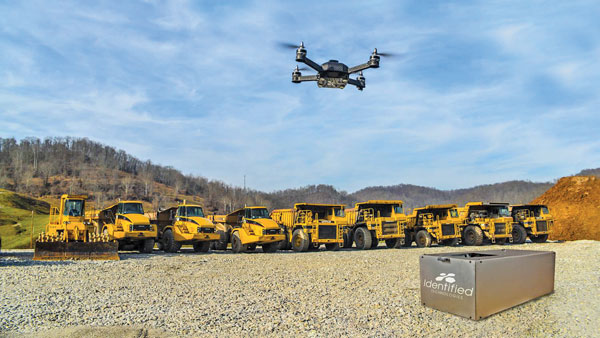For an early-stage startup in the rapidly growing realm of autonomous seacraft, Ocean Aero is making some serious waves. Born in San Diego but come of age in Gulfport, Mississippi, Ocean Aero produces a shark-shaped, solar powered, data-gathering craft called TRITON.
“We call it an AUSV, which stands for autonomous underwater and surface vehicle,” says Keith Blystone, the upstart company’s chief of staff. “We coined the term ourselves because we’re the only company in the world that actually does this.”
Far from being a mere novelty, TRITON’s ability to dive and thus avoid attack offers unique value to the U.S. Navy. The Navy’s Fifth Fleet operates a TRITON group for intelligence gathering purposes in the Persian Gulf. For maritime research and other civilian applications, the vessel’s dive capabilities allow it to weather potentially damaging storms.
Having relocated to Mississippi in 2021, Ocean Aero recently entered into a strategic agreement with shipbuilding giant Huntington Ingalls, which operates out of Pascagoula. The partnership is aimed at advancing the the companies’ respective autonomous platforms and software capabilities. Soon to move into expanded manufacturing space at the Port of Gulfport, Ocean Aero is clearly on a roll.
“We’ve been thrilled to call Mississippi home,” Blystone says. “We’ve more than doubled our workforce, and we built more boats here in 2022 than in the company’s previous nine years. We are off on a good trajectory here.”
Ocean Aero’s Blystone spoke with me at length in late May about the company’s mission and how its location on Mississippi’s Gulf Coast has served to foster its growth. This interview has been condensed for clarity and brevity.
Site Selection: What were some of the reasons for moving Ocean Aero from San Diego to Gulfport, Mississippi?
Keith Blystone: First, if you’re going to be in the business of building boats, it’s great to be surrounded by an ecosystem of other folks that are building boats. We find ourselves now in a hotbed of shipbuilding with an impressive maritime workforce that we can tap into. Second, The University of Southern Mississippi is a huge partner of ours. Having that maritime academia and state-of-the-art testing capability right in our backyard was a huge selling point. The third piece is built around the defense industry ecosystem. Having other kinds of defense-oriented companies surrounding us gives us great access to suppliers and supply chain infrastructure. And fourth would be congressional support as it relates to the defense industry and maritime and shipbuilding industries, which is supremely helpful for a company like ours. Those four pieces make Mississippi a fantastic place for us.
What more can you tell us about your partnership with Southern Miss?
Blystone: The University of Southern Mississippi has a very big maritime focus, and they are one of the nationwide leaders in the space as far as maritime academia goes. They’ve been very helpful with us in terms of working on projects together, and they’re utilizing our technology to execute some of their own research programs. They were influential in making introductions here on the coast and all the way up into Jackson. Tactically, they have an incubator for startup technologies, and we worked out of their Gulf & Ship Island Building before we had our own permanent space. We’re still in active conversations with them to work on even more projects moving forward with them. We have a great relationship.
How many people does Ocean Aero employ and in what roles?
Blystone: We just hit 45 employees earlier this year, and our extended team numbers 60 or so. It’s mainly broken down into manufacturing, engineering and administration. We’ve encountered great success with the access to engineering and manufacturing talent here along the coast. We’ve been thrilled to see that it’s a reality.
 When will you be moving into your new facility at the Port of Gulfport?
When will you be moving into your new facility at the Port of Gulfport?
Blystone: It’s slated to open later this year. It’s going to be 63,000 square feet in total, including about 50,000 square feet of manufacturing space. It’s going to be a huge wind at our back. It really helps us to tremendously expand our footprint to allow for multiple different lines running simultaneously. The port location is very valuable to us from a tactical perspective of being able to do a lot of our dive testing right here outside our back door. And, again, it’s very helpful for us to be around other partners.
Late last year, TRITON took part in exercises held by the U.S. Navy in the Persian Gulf. That had to be a point of validation for Ocean Aero.
Blystone: Absolutely. That exercise was called Visual Horizon and it was held off Bahrain. There was also IMX 2023 [the Middle East region’s largest maritime exercise], and that was in February and March of this year. We’re very excited to have worked with both of those. But beyond just being in the demonstration space, we’re also excited to be helping the Navy’s Fifth Fleet operationally. There are multiple TRITONs actively working over there in service of the U.S. Fifth Fleet.
Is there a role for TRITON in the buildout of offshore wind facilities in the Gulf of Mexico?
Blystone: It’s a big opportunity for us. We think we can provide a lot of benefits to offshore wind operators, both before and after these facilities are erected with pre-site survey work and then various monitoring functions. A big reason for our partnership with Huntington Ingalls is precisely for this kind of work. It’s doubly exciting for us since they happen to be neighbors of ours here on the coast. It’s two companies that are able to link arms here and solve some difficult problems together. They’re a great company, they’ve been great partners and we are enormously proud to be working with them.
How would you assess the support you have received during the process of moving operations from California and establishing a foothold on the Gulf Coast?
Blystone: Not only the Port of Gulfport but the Mississippi Development Authority have been very forward-looking in allowing an early-stage company such as ours to be located here. We don’t currently have the balance sheet of a Lockheed Martin or other giant defense company. For them to have had the foresight to allow us to be on the port and see the value we can bring, see the jobs we are going to create and the great, new technology we can provide is very valuable. I really commend the state of Mississippi for taking a chance on a company such as ours.





